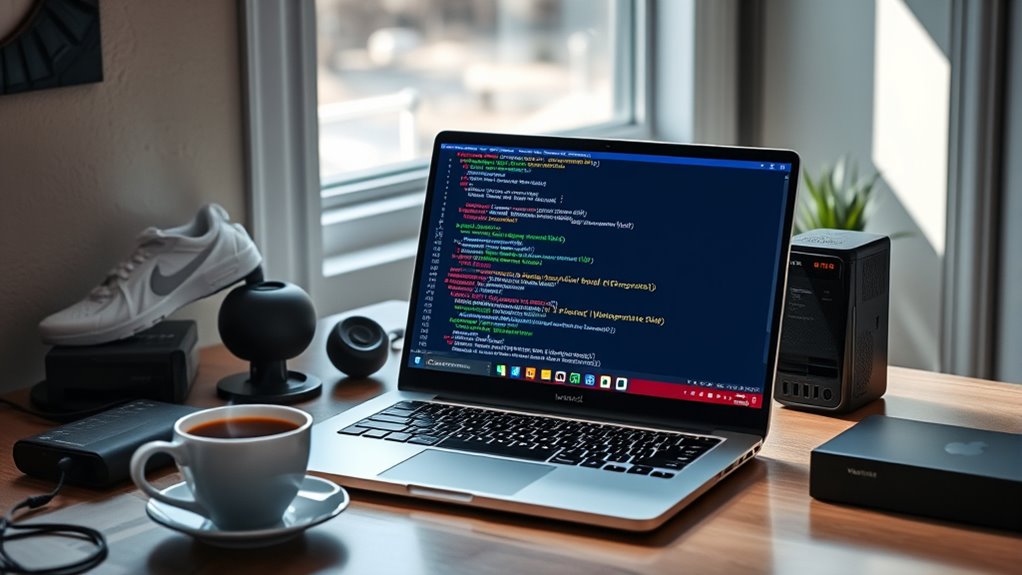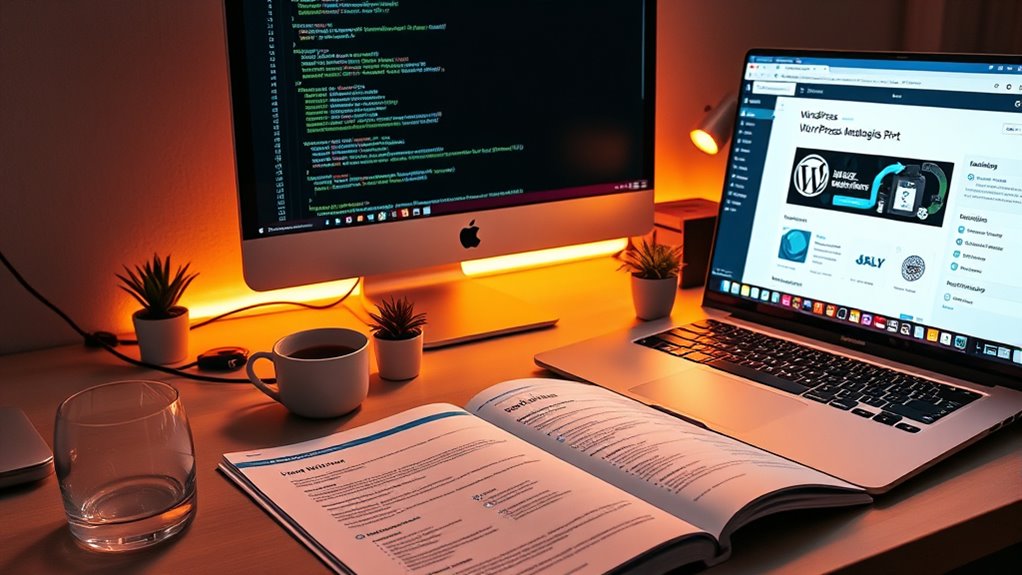To install WordPress on a VPS quickly, start by choosing a reliable hosting provider and setting up your server. Log in via SSH, update packages, and install a web server like Nginx or Apache. Next, install PHP and a database system, then download and extract WordPress into your web root. Configure your database, secure your settings, and finish the setup. Continue along this guide to uncover expert tips and optimization methods to get your blog live in no time.
Key Takeaways
- Set up your server: choose a VPS, update packages, and install a web server like Nginx or Apache.
- Secure the server: configure firewalls, create strong passwords, and enable SSL with Let’s Encrypt.
- Install PHP and a database (MySQL/MariaDB), then create a dedicated database for WordPress.
- Download and configure WordPress, setting proper permissions and connecting it to the database.
- Complete the setup via browser, then optimize with caching, compression, and regular updates.

Setting up WordPress on a VPS might seem complex, but with the right steps, you can have your site running smoothly in no time. The key is to follow a straightforward process that prioritizes security best practices and server optimization from the start. First, you’ll want to choose a reliable VPS provider and set up your server environment. Once you’ve logged into your server via SSH, update your system packages to ensure everything is current. This step helps prevent security vulnerabilities and improves server performance. Installing a web server like Nginx or Apache is next; Nginx is often preferred for its speed and efficiency, but Apache works well too. Remember, optimizing your server settings here can dramatically impact load times and stability, so tweak configurations for better performance.
Choose a reliable VPS, update packages, and optimize your server for fast, secure WordPress hosting.
Security should be at the forefront of your setup. Implementing security best practices is essential; start by creating a strong, unique password for your server and disabling root login via SSH. Consider setting up a firewall, such as UFW, to restrict access to necessary ports only. Installing an SSL certificate, ideally through Let’s Encrypt, encrypts data transmitted to and from your site, boosting security and trustworthiness. Additionally, make sure to keep your server and all installed software up to date to patch known vulnerabilities. Regularly checking for and addressing security vulnerabilities is crucial to maintaining a safe hosting environment.
Next, you’ll want to install PHP and the necessary database system—MySQL or MariaDB—optimized for WordPress. Configuring PHP-FPM can improve performance by managing PHP processes more efficiently. Afterward, create a dedicated database and user for your WordPress installation, assigning only the necessary permissions to limit potential damage if your site becomes compromised. Download the latest version of WordPress from the official site, extract it into your web root, and configure the wp-config.php file with your database details. Set the appropriate file permissions to prevent unauthorized access.
Once you finish the configuration, run the installation script through your web browser, and within minutes, you’ll have a fresh WordPress site. Don’t forget to enhance server optimization by enabling caching plugins, configuring gzip compression, and minifying CSS and JavaScript files to speed up your site. Regularly backing up your database and files ensures quick recovery if issues arise. By following these steps, you’ll have a secure, optimized WordPress site on your VPS, ready to grow without unnecessary delays.
Frequently Asked Questions
How Do I Secure My VPS Before Installing WordPress?
To secure your VPS before installing WordPress, start with firewall configuration to block unnecessary ports and restrict access. Next, review and set proper user permissions to limit who can make changes, reducing security risks. Regularly update your server’s software and disable root login via SSH. These steps help protect your server from potential threats and guarantee a safer environment for your upcoming WordPress installation.
Can I Install WordPress Without Root Access?
You can install WordPress without root access, similar to how you set up on shared hosting with limited permissions. Instead of full server control, you’ll use your hosting panel or FTP to upload files and create databases. While you can’t install server-wide software, many managed hosting providers and VPS setups allow WordPress installation through one-click installers or manual uploads, making it accessible even without root privileges.
What Are the Best Performance Optimization Tips for WordPress?
To boost WordPress performance, focus on caching strategies like using plugins such as W3 Total Cache or WP Super Cache to reduce server load. Optimize your images by compressing them without losing quality, which speeds up load times. Additionally, use a content delivery network (CDN) and keep your themes and plugins updated. These steps help guarantee your site runs smoothly and loads quickly for visitors.
How Do I Set up SSL Certificates on My VPS?
To set up SSL certificates on your VPS, start by choosing a trusted provider like Let’s Encrypt. Initiate domain validation through DNS or HTTP verification. Once validated, install the certificate on your server, ensuring secure HTTPS connections. Remember, SSL certificates require periodic renewal; set up automatic renewal to avoid expiration issues. This process guarantees your site’s security and builds trust with visitors.
What Should I Do if WordPress Installation Fails?
When your WordPress installation falters, remember the resilience of Odysseus steering storms. First, check your backup strategies—restore a recent backup if needed. Then, troubleshoot by reviewing error messages, verifying server requirements, and ensuring correct permissions. Clear cache, update software, and revisit installation steps. If issues persist, consult logs or community forums. Staying methodical helps you conquer installation failures and get your site running smoothly again.
Conclusion
So, after just 20 minutes, you’ve transformed a blank VPS into a fully functional WordPress blog. Who knew that setting up a website could be so quick and easy? It’s almost amusing how simple it was—almost like magic. Now, you’re ready to conquer the web, all thanks to a few commands and a bit of patience. Now go ahead, enjoy your shiny new blog—because what could possibly go wrong?









